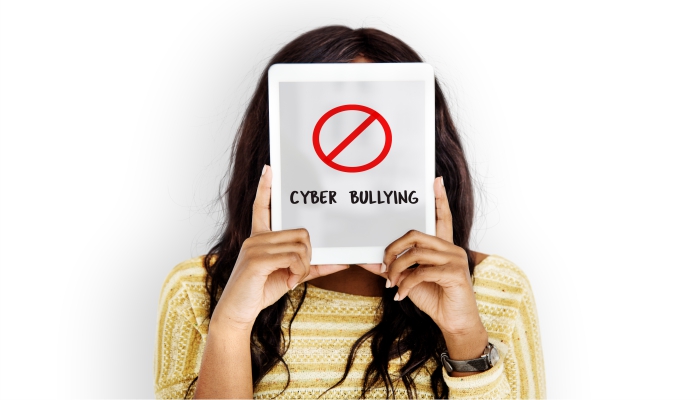Cyberbullying
What is bullying
Bullying is repeated aggressive behavior that can be physical, verbal, or relational, in-person or online. Bullies are often relentless, bullying over and over again for long periods of time. You may live in constant fear of where and when the bully will strike next, what they’ll do, and how far they’ll go.
- Physical bullying
- Verbal bullying
- Relationship bullying
includes hitting, kicking, or pushing you (or even just threatening to do so), as well as stealing, hiding, or ruining your things, and hazing, harassment, or humiliation.
includes name-calling, teasing, taunting, insulting, or otherwise verbally abusing you.
includes refusing to talk to you, excluding you from groups or activities, spreading lies or rumors about you, making you do things you don’t want to do.
Boys frequently bully using physical threats and actions, while girls are more likely to engage in verbal or relationship bullying. But no type of bullying should ever be tolerated.
What is Cyberbullying?
Cyberbullying is a form of bullying that takes place via internet connected devices like smartphones, computers, or tablets. Cyberbullying can occur via social media, email, messaging apps, text messages, forums, games, and more. Any online medium that allows for the sharing of information can become a platform for cyberbullying.
Technology means that bullying is no longer limited to schoolyards or street corners. Cyberbullying can occur anywhere, even at home, via smartphones, emails, texts, and social media, 24 hours a day, with potentially hundreds of people involved. Cyberbullies use digital technology to harass, threaten, or humiliate you. Unlike traditional bullying, cyberbullying doesn’t require face-to-face contact and isn’t limited to just a handful of witnesses at a time. It also doesn’t require physical power or strength in numbers.
Cyberbullying differs from in-person bullying (although the two are not mutually exclusive) in that it can be:
More difficult to recognize – What children and teenagers do online is not always readily apparent to parents and teachers. Bullying conducted via text or online medium can more easily go unnoticed.
More relentless – Cyberbullying doesn’t end at school, and can follow a child home.
More enduring – Cyberbullying leaves a paper trail that can follow both the bully and the victim for years
Different Types of Cyber Bullying
Parents and educators should be aware of the different types of cyberbullying, so they can adopt measures to prevent and confront it. Common forms of cyberbullying include:
Doxing – publishing revealing personal information about an individual online, for purposes of humiliating, defaming, or harassing the victim
Harassment – posting hurtful, threatening, or intimidating messages online, or sending them directly to someone, with the intention of harming that person
Impersonation – creating fake accounts or gaining access to a person’s real social media accounts and posting things to damage the victim’s reputation
Cyberstalking – tracking and monitoring a person’s online activity, and using the internet to stalk or harass an individual
How to Prevent Cyber Bullying?
As cyberbullying becomes more prevalent, it is increasingly important for parents and educators to take steps to prevent it. Here are some tips for adults to prevent cyberbullying:
- Be aware of your child’s online activities
- Watch for the following signs of cyberbullying in children:
- Refusal to allow you to see what they are doing online
- Avoidance of discussing what they are doing online
- Sudden, unexplained increase or decrease in online activity
- Deactivating social media accounts
- Emotional responses (including sadness, anger, happiness) linked to their device usage
- Refuse to participate in, or aid cyberbullying (including refusing to pass along cyberbullying messages, refusing to
- allow their friends to partake in cyberbullying, and refusing to communicate with cyberbullies)
- Never share passwords for their online accounts
- Never put something online that they wouldn’t want everyone to see
- Block communication with cyberbullies and do not read messages
Children should not be allowed to browse the internet freely. Parents and teachers should monitor the sites that the children use and be cognizant of the apps they download and digital media they consume. Children should have their screen time limited, and be encouraged to engage more in offline activities
Adults should also teach children to recognize and be aware of the signs of cyberbullying themselves. Children are often less aware of cyberbullying than adults. Make sure your children are aware of what cyberbullying is, and teach them the following tips:
Prevent cyberbullying before it starts
One of the best ways to stop cyberbullying is to prevent the problem before it starts. To stay safe with technology, teach your kids to:
-
Refuse to pass along cyberbullying messages.
-
Tell their friends to stop cyberbullying.
-
Block communication with cyberbullies; delete messages without reading them.
-
Never post or share their personal information—or their friends’ personal information—online.
-
Never share their Internet passwords with anyone, except you.
-
Talk to you about their life online.
-
Not put anything online that they wouldn’t want their classmates to see, even in email.
-
Not send messages when they’re angry or upset.
-
Always be as polite online as they are in person.

